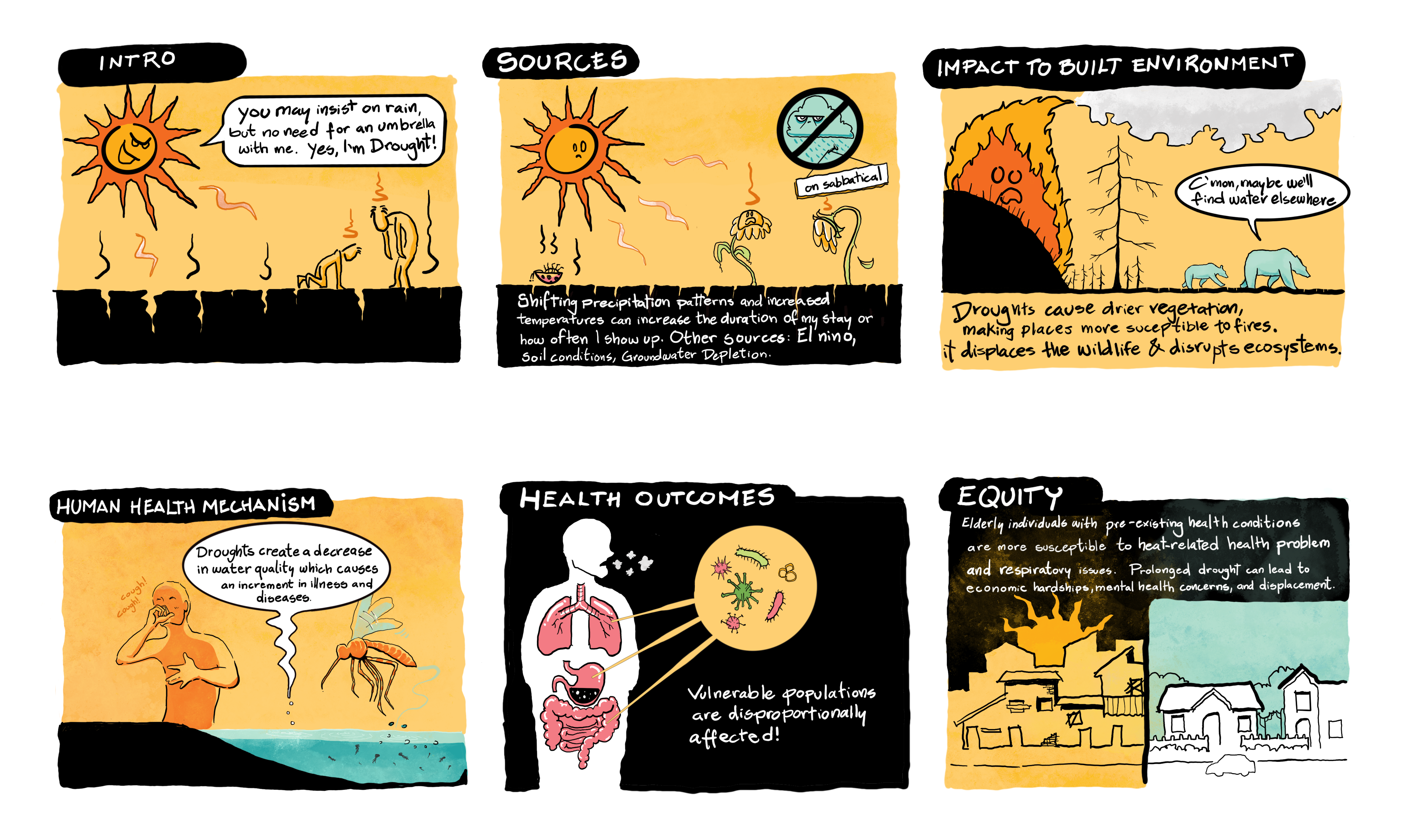
Click here for caption
Transcript: Hi, I’m drought! Did you know that over the last century, droughts have caused more deaths internationally than any other weather-or climate-related disaster? I’m also notoriously hard to define because determining drought is heavily dependent on the area, needs and approaches. The American Meteorological Society defines me as “A period of abnormally dry weather sufficiently long enough to cause a serious hydrological imbalance.” In a drought condition, the vegetation may get drier making fires more likely. It also disrupts local ecosystems and food systems. Drought impacts on public health include changes in air quality, changes in water quality and quantity, increased incidence of illness and disease, and mental health effects. On your physical well-being, droughts can effect respiratory health, spread infectious disease, and disrupt & displace individuals, families, and communities. Vulnerable populations—people living in neighborhoods with social factors such as poverty, lack of vehicle access, or crowded housing—may be disproportionately affected by drought impacts.
Definition
A drought is a deficiency of precipitation over an extended period of time resulting in a water shortage.
Human Health Mechanism
During drought events, air quality often deteriorates due to dust storms and wildfires, resulting in the presence of harmful particulates in the air that can irritate the lungs and exacerbate chronic respiratory conditions. Furthermore, drought conditions can alter the frequency and distribution of certain diseases. For example, the movement of mosquitoes carrying West Nile virus can shift as stagnant water bodies create new breeding grounds. Additionally, dry and dusty soil conditions increase the risk of contracting Valley Fever, a lung infection caused by soil-dwelling fungi. Moreover, the intricate interplay between drought and its associated economic consequences may contribute to elevated rates of mood disorders, domestic violence, and suicide.
Indicator Measurement
The US Federal Emergency Management Agency (FEMA) National Risk Index calculates a Drought Risk Index score to represent a community’s relative risk for droughts when compared to the rest of the US. The Drought Risk Index is based on the summed dollar value of all crop agriculture areas expected to be lost each year due to droughts and is derived using historical drought data available for each census tract from 2000 – 2021.
Source of Exposures
Related Health Outcomes & Exposures
PM2.5, Air Quality, Respiratory Health, Wildfire, NDVI
References
Click here for References
- Drought Data Source: Climate Mapping for Resilience and Adaptation (CRMA). US FEMA National Risk Index: Drought. Data year 2021. Accessed April 2023. https://resilience.climate.gov/datasets/FEMA::national-risk-index-census-tracts/about
- Li Y, Sun J, Lei R, et al. The Interactive Effects between Drought and Air Pollutants on Children’s Upper Respiratory Tract Infection: A Time-Series Analysis in Gansu, China. Int J Environ Res Public Health. 2023;20(3):1959. Published 2023 Jan 20. doi:10.3390/ijerph20031959
- Paull SH, Horton DE, Ashfaq M, et al. Drought and immunity determine the intensity of West Nile virus epidemics and climate change impacts. Proc Biol Sci. 2017;284(1848):20162078. doi:10.1098/rspb.2016.2078
- US FEMA. National Risk Index: Drought. hazards.fema.gov. Accessed November 10, 2023. https://hazards.fema.gov/nri/drought
- World Health Organization (WHO). Drought. World Health Organization. Published 2022. https://www.who.int/health-topics/drought#tab=tab_1
